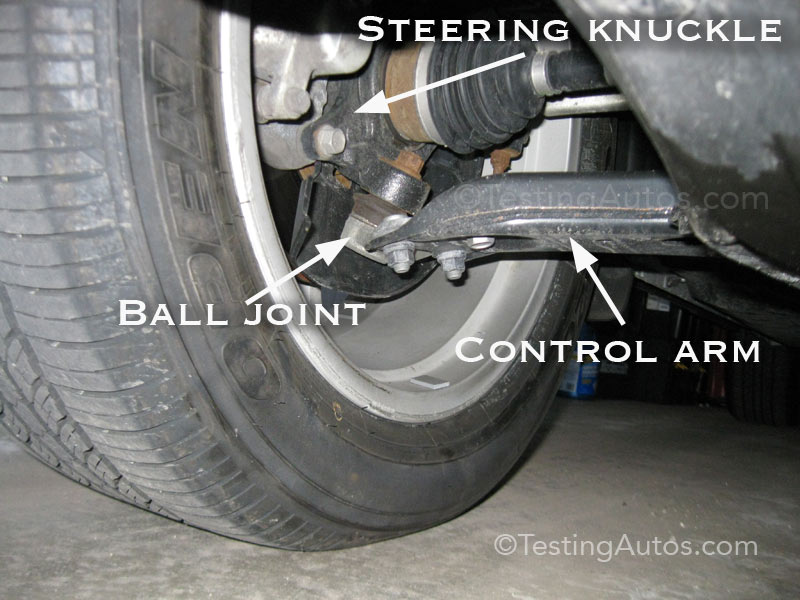
Bad Ball Joint Symptoms and Signs 1. For some people passing over a pothole is enough to make the noises.

One of the most common symptoms associated with excessively worn rear ball joints is a clunking noise coming from the affected ball joint.
Bad ball joint noise. How to check ball joints and ball joint noise. Learn how to diagnose a bad ball joint for both an upper and lower control arm. I also quickly show you how to.
Sound Usually the first indication of worn or loose ball joints will be a faint intermittent clunking noise that seems to be coming from a corner of your vehicle. The sound may be more pronounced when going over a bump or a dip or when going around a corner. WHEN I GOT THE CAR BACK FROM.
How to Know When Ball Joints Are Bad Driving. The first indication of wearing ball joints can be very subtle and develop slowly enough that you may not. Loud banging or popping noises are a primary indicator of bad ball joints but the type and degree of the noise.
If you are able to hear loud thudding noise while driving it is about the bad ball joints. Even a slight bump or getting your car through the pothole can make you hear the noise. It indicates that there is a problem with the suspension and due to the worn parts the shock-absorbing property is not working well.
How to Tell if You Have a Bad Ball Joint Metallic clunking noise. One of the most noticeable and common symptoms of a bad ball joint is a clunking or knocking. Because ball joints are constantly moving they require grease for lubrication.
This grease makes the. Symptoms of a Bad or Failing Ball Joint Front 1. Clunking Noises From the Front Suspension.
One of the most common symptoms of a problem with suspension ball joints. Excessive Vibration From the Front of the Vehicle. Another symptom of problematic ball joints is excessive vibration.
Clunky or squeaky noises Drifting to the side Loose or shaky steering Uneven tyre wear. Bad Lower Ball Joint Symptoms 1 Vibrations. When you have a bad lower ball joint you will be able to feel vibrations in the steering wheel or from.
A symptom of a faulty lower ball joint that people experience on a regular basis is clunking sounds. One sign of a. One ball joint is placed on the farthest edge of both the upper and lower control arms.
The ball joint connects the control arms to the steering knuckles on either side of the vehicle. Ball joints do go bad over time and must be replaced. Otherwise there may be safety issues.
Bad Ball Joint Symptoms and Signs 1. Excessive Vibration From the Front End. When ball joints wear down they lose their lubrication and begin to rust.
Clunking Creaking and Squeaking. One of the most common symptoms of ball joint wear and tear is a clunking noise. One of the most common symptoms of a problem with suspension ball joints is clunking noises coming from the vehicles front suspension.
As ball joints wear out they become loose in the socket and. One of the most common symptoms associated with excessively worn rear ball joints is a clunking noise coming from the affected ball joint. When a ball joint begins to wear out it will become loose in its socket and clunk or rattle when force is placed upon it.
Suppose you start experiencing loud thuds when driving. It could be a sign of bad ball joints. The intensity of the sound will depend on how bad the damage is.
For some people passing over a pothole is enough to make the noises. Others need to move through dirt roads to experience this noise as their ball joints are relatively good. Vibration A bad control arm really means theres a bad ball joint or worn control arm bushings.
When these components fail you can experience symptoms ranging from clunking noises to steering wander. This article will highlight the symptoms along with the reasons for control arm failure and what to do about it. Over time a cars ball joints may wear down.
If a ball joint starts to loosen youll hear clunking sounds from the front as the joint rattles in the socket. If it tightens up the steering will bind so you can have a stiff spot as you turn the steering wheel. There may be a binding or squeaking sound in addition to the stiff spot.
As ball joints start to go bad they will become loose in the socket. This looseness will allow a knocking sound or rattle from the front of the vehicle when the truck goes over a dip or a speed bump. Most often the clunking will get louder as the ball joints become more worn out before finally breaking.
The classic sounds of a bad wheel bearing are cyclic chirping squealing andor growling noise. You can also tell that the sound is related to wheel bearings if it changes in proportion to vehicle speed. The sound can get worse with every turn or it can disappear momentarily.
Rear Differential Noise vs Wheel Bearing Noise.